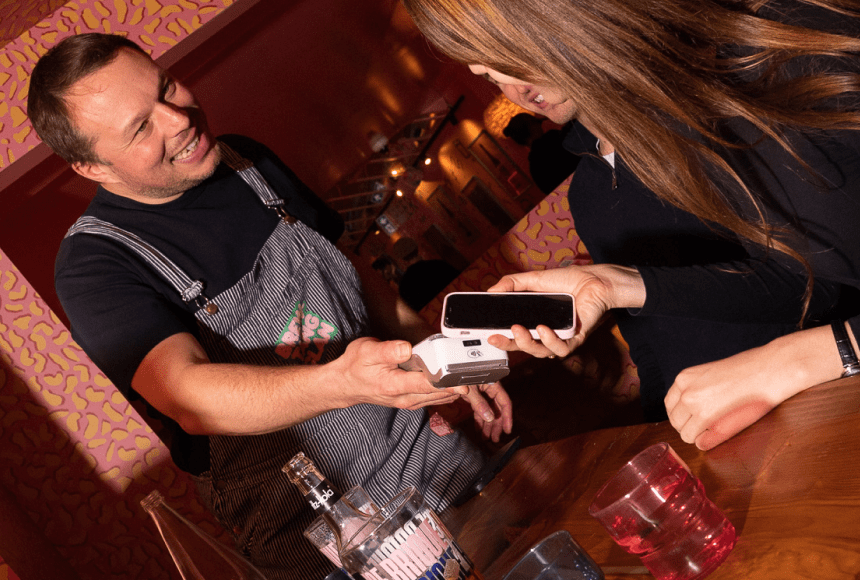
Reimagining Card Machines in the Hospitality World
Where Did “Smart Payment” Come From?
If you’ve been in the restaurant business for even a few years, you’ve probably witnessed a transformation in how diners expect to pay. Just a decade ago, handing over a card to a server who then punched numbers into a bulky terminal was the norm. Now, the tide has turned: contactless “taps,” mobile wallets, and at-table QR code payments have reshaped what “paying the bill” looks like.
In this evolving landscape, the idea of a “smart payment terminal” — one that does more than just process transactions — is making waves among hospitality operators. Some see it as a mere gadget, a fancy piece of tech that won’t meaningfully change everyday service. Others hail it as a game-changing revolution that streamlines workflow and delights customers. So which view is closer to reality? Let’s explore the rise of these next-generation card machines (and beyond) to find out what they truly offer restaurants today.
Defining the “Smart” in Smart Payment Terminals
A basic credit card reader can accept chip-and-PIN or contactless payments. That’s its job, and it does it well enough. But a smart terminal goes further, often featuring:
- Built-In Connectivity: Many have 4G or Wi-Fi, linking directly to the internet without requiring a separate pairing device.
- App Integration: Some run on Android-based platforms, enabling you to install POS or ordering apps right on the terminal.
- Digital Receipts and Emails: Instead of printing every time, these devices can send customers a receipt via email or text, cutting paper waste.
- Custom Tip Prompts: With a touchscreen, they can prompt diners to leave a certain percentage or a set amount, making tipping more transparent and potentially boosting gratuities.
The goal? To merge payment processing with additional functions that make life easier for both staff and guests. Instead of having multiple devices or complicated add-on systems, a truly “smart” terminal can be an all-in-one solution, from placing orders to finalising the check.
How Smart Payment Impacts the Dining Experience
Adopting new hardware might feel daunting. Yet, restaurants that have experimented with modern payment terminals often see quick operational improvements. At first glance, it’s about speeding up the payment process, but it has ripple effects on the entire guest journey.
- Reduced Waiting: If your server doesn’t need to dash back and forth to a stationary POS for each transaction, diners settle up faster — especially vital when multiple parties want to pay at the same time.
- Interactive Screens: Some solutions let customers scroll through their ordered items. If they notice a missing dessert, they can catch it before final payment. This transparency minimises disputes or confusion on the bill.
- Uplift in Tips: As with digital tip prompts on phones, a user-friendly interface on a terminal that invites a tip can boost overall gratuities. Diners appreciate being guided to a fair tip rather than scrambling to do mental maths.
- Positive Perception: Today’s diners are used to streamlined digital experiences in almost every aspect of life. Offering a slick checkout process can position your restaurant as modern, efficient, and guest-focused.
A McKinsey report (Retail insights) notes that customers increasingly expect technology to enhance convenience. Smart payment terminals can be your step towards meeting — or exceeding — those expectations.
Addressing the “Gadget” Label: Is It Just Hype?
Critics might say, “Sure, it’s shiny and new, but is it really necessary?” A fair question. After all, if your existing card machine works fine, why invest in a pricier device just to accept payments in a slightly fancier way?
However, calling it a mere gadget might overlook the bigger picture. A truly integrated payment terminal can:
- Link Directly with POS: Some advanced terminals sync with your restaurant’s main system, automatically updating checks. This eliminates double-entry or potential mistakes when staff manually input data later.
- Enable Tableside Ordering: If the terminal includes an ordering app, servers can ring up items while standing at the table. Fewer mistakes occur, and the kitchen sees orders more rapidly.
- Gather Insights on Customer Behavior: Certain models let you capture data about average spend, popular items, or tip patterns. That knowledge can guide menu tweaks or marketing tactics.
So, while it might feel gadget-like, the operational boost can be quite real. The trick is picking a setup that genuinely meshes with your workflow and doesn’t just add bells and whistles you’ll never use.
Potential Hurdles to Consider
Switching to a new payment device isn’t without its downsides. Before leaping in, weigh the following:
- Cost: Smart payment terminals can cost more upfront. You’ll want to calculate if the potential efficiency gains and tips offset that. Many restaurants find the ROI is worth it, but it’s key to do the maths.
- Staff Training: Even user-friendly devices take some adjustment. Servers need to be comfortable navigating the interface and explaining it to diners.
- Battery and Connectivity: If your terminal runs on Wi-Fi or 4G, you must ensure consistent coverage. Dead zones or battery shortfalls can annoy both staff and customers.
Address these concerns early by selecting devices with proven reliability, offering robust training sessions, and possibly keeping a traditional terminal as a backup if you’re feeling cautious.
Smart Payment vs. QR Code Solutions
A question arises: Why invest in a new device if you can let diners pay on their own phones via a QR code? Payment apps like Sunday enable exactly that — scanning a code at the table, viewing the bill, and completing the transaction with minimal staff involvement.
Here’s a quick comparison:
- Smart Terminal: A handheld or standalone device that staff bring to the table. It can unify ordering and payment, but still depends on the server being present. Suits restaurants that value control and prefer staff-managed processes.
- QR Code Payment: No extra hardware. Diners scan a code with their phone, see the bill, and pay instantly. It frees up staff from payment tasks, though some diners might be less tech-savvy, or you might need signage to explain how to use it.
In reality, these two methods can coexist, giving guests a choice. The main point is that both solutions go beyond a standard card machine’s capabilities, unlocking new potential in payment speed and overall experience.
Integrating with Your Existing Setup
If you lean towards a new terminal, you don’t necessarily have to replace your entire POS or shift your entire ordering system. Many smart terminals are designed to slot into your existing ecosystem.
- API Connections: Some providers offer an API that your register system can talk to. That way, completed payment info flows back into your main platform, automatically closing checks.
- Plug-and-Play Options: For smaller venues, certain terminals function well as an independent payment solution. You can keep your existing POS for order management, then simply reconcile payments at day’s end.
- Cloud-Based Sync: If your POS is cloud-based, your new smart terminal may just need a login. This method can drastically reduce manual entry or mismatched totals.
Yes, there’s some setup involved, but many restaurants find they don’t need an extensive tech overhaul. They simply integrate or connect the new device and begin enjoying faster checkouts.
How Smart Terminals Can Increase Revenue
It’s not just about looking futuristic. When done right, a more advanced payment approach can boost your bottom line. For instance:
- Speedy Table Turnover: A BigHospitality article (BigHospitality data) highlighted how even shaving five minutes off each table’s checkout can enable extra seatings during peak periods. More seatings often mean more sales.
- Impulse Upsells: If your terminal supports tableside ordering, servers can quickly add a dessert or coffee while guests settle the bill. That final nudge might not happen if the POS is elsewhere and the moment passes.
- Higher Tip Averages: As mentioned, digital tip prompts often push gratuities up, benefiting staff morale and loyalty. Happy employees can translate into better service, attracting repeat custom.
Combining these perks can improve revenue, often paying off the device’s cost in a reasonable timeframe. As with any investment, measure performance to confirm your device is delivering the expected ROI.
Tactical Advice for a Smooth Transition
- Involve Your Team Early:Present the new system as a helpful tool, not a forced change. Ask for feedback or concerns, and highlight how it reduces repetitive tasks (like running cards back and forth).
- Leverage Vendor Support:Reputable providers offer training materials, demos, or dedicated account managers to help you integrate and configure the terminal. Make full use of these resources.
- Test During Off-Peak Times:Don’t throw the new device into your busiest Friday shift on day one. Trial it on a slower midweek lunch, note any glitches, then refine your approach before prime time.
- Monitor Usage and Feedback:Observe how diners and staff interact with the terminal. Are certain steps confusing? Are some employees reluctant to use it? Address these hiccups through refresher training or adjusting the device’s settings.
A measured, step-by-step introduction keeps stress levels down and encourages a positive reception from all parties.
Customer Perceptions: Impressing the Tech-Savvy
Much of your success relies on how diners respond. Younger guests might gravitate toward any modern convenience, from contactless payments to scanning a code for menus and paying with an app like Sunday. But older patrons can also warm to a simpler experience that means no waiting for a device or fiddling with small card slots.
Emphasise your terminal’s ease of use. If it prints receipts on the spot for those who want them, or emails a digital copy instantly, that’s a plus. Keep basic instructions on the table or train servers to politely walk newcomers through the process. Over time, the novelty factor fades, and it just becomes your normal, efficient payment flow.
Deciding If It’s Right for You
Whether you see a smart payment terminal as an optional upgrade or a critical piece of your future strategy can depend on:
- Your Volume: High footfall sites may benefit more from saved minutes per transaction.
- Staffing Model: If you’re short-staffed, a device that reduces repeated trips to a POS can significantly relieve the burden.
- Tech Environment: If your POS is archaic and incompatible, a new device might require extra workarounds. Alternatively, you might be ready to refresh the entire system and adopt a more integrated approach.
- Budget and Objectives: Are you aiming to speed up table turnover? Increase average tips? Offer a cutting-edge impression? Clarify these goals to see if the value lines up with the cost.
In many cases, the real tipping point is when you weigh how much friction currently exists around payment in your restaurant. If staff or guests regularly mention it as a frustration, a new approach could be exactly what you need.
Wrapping Up: A Small Step Toward a Big Shift
Smart payment terminals may first appear as a futuristic or “nice-to-have” gadget. But for many restaurant owners, they represent a logical evolution in line with the broader changes in how people dine, order, and pay. When done correctly, this technology can enhance the end-of-meal experience, trim a few minutes from each table’s total occupancy, and potentially raise staff tips.
In other words, they can be more than a flashy device. They can fundamentally refine how you handle each transaction, from ordering to final sign-off. The real question is whether you want to keep relying on standard card machines that do one thing decently — or open the door to a multipurpose, integrated solution that meets modern diners’ expectations.
It’s not about technology for technology’s sake. Instead, it’s about making everyday tasks simpler, freeing your team for genuine hospitality, and boosting that intangible sense of efficiency and care in your venue. In that sense, smart payment terminals aren’t just gadgets. They’re part of a broader revolution that’s reshaping the hospitality industry, one tap (or scan) at a time.
Find out more today
Drop us your details below and we’ll reach out within the next 24
The payment terminal to make your operation simpler.
Connected to your POS, we offer the only payment terminal specifically designed for restaurants.


